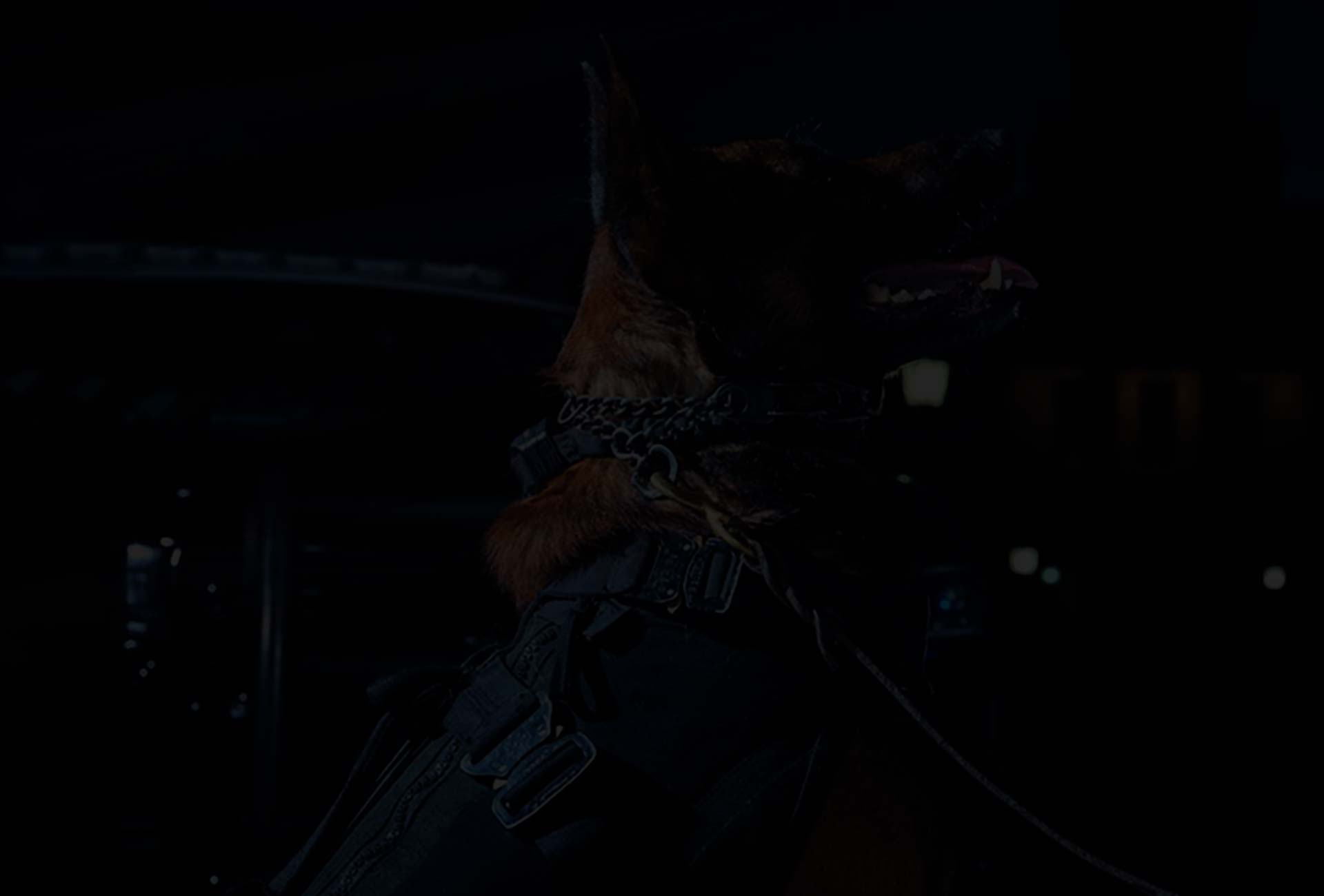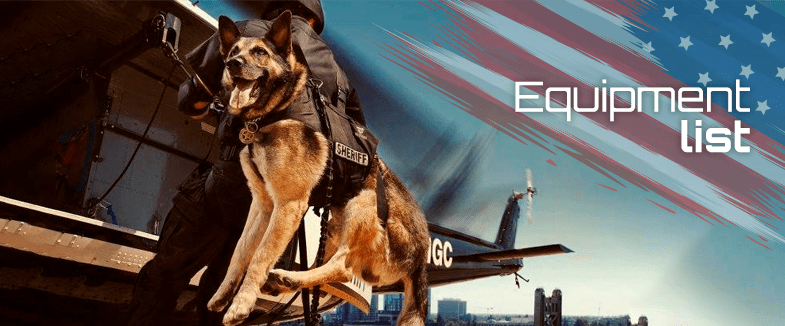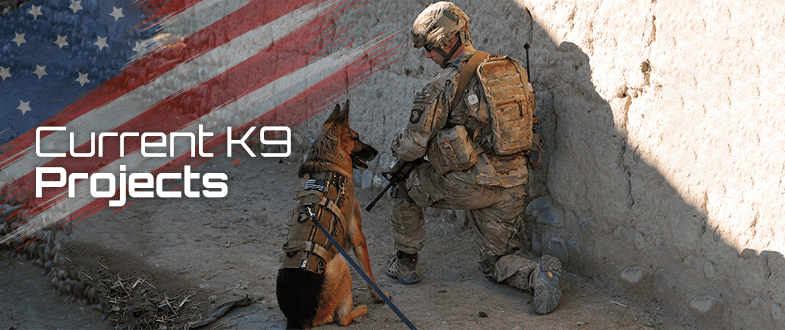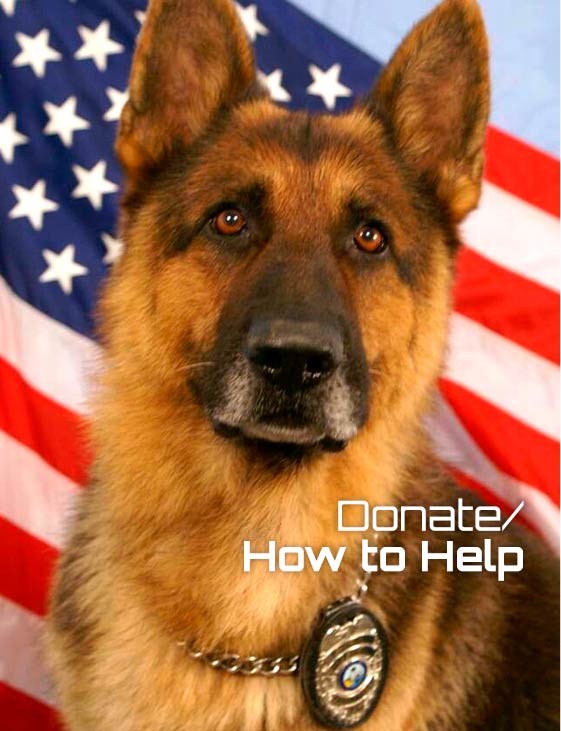FAQ's
1. What is Project Paws Alive?
Project Paws Alive is a Nationwide non-profit organization working to provide protective K9 equipment to underfunded Law Enforcement, Fire, Search & Rescue, and Military K9 Units throughout the United States. The specialized and custom K9 equipment includes, but is not limited to: K9 bullet & stab resistant ballistic vests, K9 First Aid Field Trauma Kits, K9 PCM Military Grade Cooling Vests, K9 Narcan kits, pet oxygen recovery mask kits, and K9 vehicle heat alarm systems with the “No K9 Left Behind” and “WatchDog” features.2. How much does all this cost?
Each K9 vest is custom-built using high-end ballistic material and costs $1400 depending on the size of the K9 and specific agency equipment requirements. Each law enforcement agency has different requirements and the final overall cost is reflective of those customizations. Specialized SWAT K9 Tactical ballistic vests are also an option and start at $3700. K9 first aid field trauma kits are $350. Each of these items is specifically designed and ordered to meet specific agency needs, and K9 size where applicable. While the cost of these items is rather high, we believe that a price cannot be placed on the lives they save. We donate only the highest quality equipment to ensure a long duration of usability and to ensure this equipment holds up to the stress and use they will encounter on a daily basis. Our equipment advisory board consists of active K9 handlers and is constantly reviewing equipment to ensure only the best is donated. All equipment donated by Project Paws Alive exceeds NIJ standards, and most is military grade.3. Is it worth the expense? After all, they’re just dogs and pets, right?
Law Enforcement K9s and Military dogs (MWDs) are not just dogs. These K9s are highly trained, intelligent, and specialized. Most of them hold multiple certifications for which they must certify yearly. As law enforcement and military activities becomes increasingly dangerous, agencies are relying increasingly more on the agility, versatility, speed, stamina, and senses of K9s to protect officers and citizens. Given the substantial investment of time and money in each dog’s training and care, as well as their contribution to the success of the agencies, it makes sense to protect them as they serve our community and country. Trained K9s can cost anywhere from $20k - $50k depending on their breeding, training, specializations, and health care costs. The investment in a protective vest and field kit greatly extends the duration of the K9’s life and ultimately reduces the costs most agencies would likely incur if the K9 is injured or killed on duty.4. Does a dog or cat really need an oxygen mask? Can’t they just use the normal masks used by most fire and EMT?
No. If you have pets, then take a look at the oxygen masks your veterinarian has on-site. You will notice that they are of different shapes and widths to be used depending on the species and size of the animal. For example, a small mask that fits a Chihuahua or cat would most likely not fit a Great Dane. Birds, and smaller animals like hamsters and reptiles (yes, we said reptiles) require much smaller and longer masks. The variations in size continue depending on the specific animal, but the takeaway here is that we cannot expect a human oxygen mask to fit a pet, especially when you consider that the masks specifically made for pets come in 3 different sizes. First responder agencies are typically not permitted to spend funds on equipment not designed to save human lives. Because these first responders cannot use equipment that is not on their truck, they are often left with little to no options to save the lives of domestic pets that have suffered from smoke inhalation, or pets that need to be resuscitated after losing consciousness from exposure to dangerous toxic fumes.5. Do you make the equipment?
No. We neither make nor do we support the use of “home-made” products. When lives are at stake, only professionally made and field tested equipment should be used to ensure reliability and usefulness of the product as well as provide a warranty for the products. Those offering cheaper solutions are not offering the same quality of items and rarely provide any warranties. Additionally, the cheaper options such as first aid kits that are assembled by hand and not under professional regulations (referred to as home-made) are often compiled through use of discounted bulk purchase items that have sat on a shelf, which should not be done. Items in professional grade K9 first aid kits have expiration dates and should only be assembled when ordered to ensure a “fresh” product and provide the longest useful lifetime of the product as possible.6. I am a K9 handler; how can I request a vest for my unit/canine?
Units and handlers should refer to the Request Equipment page for information about requesting K9 equipment. Please note that all requests are screened and verified. You must be part of a legally recognized first responder agency located in the United States to be considered for one of our campaigns/fundraisers.7. My local Law Enforcement department doesn’t have a K9 unit. Where does my donation go?
Areas which do not have a K9 unit receive coverage from another local, county, or state K9 division. If your local agency does not have any K9s, then your donation is pooled to provide equipment to a K9 unit servicing the closest area.8. How much of my donation will actually go to Project Paws Alive?
Project Paws Alive is a 501(c)(3) non-profit organization and will receive 100% of your donation. In addition, all donations are tax-deductible. Donations made by PayPal or another third-party payment system will incur standard processing fees and the remaining amount will be transferred to Project Paws Alive. Fees and rates are determined by these third-party providers directly and are subject to change. If you wish to avoid these fees, we encourage you to donate via check or money order mailed directly to Project Paws Alive.9. How much of my donation will actually go to funding a campaign or equipment?
100% of your donation gets allocated to the campaign or equipment to which you donate. If you elect to donate or pay online via PayPal or another third party, there is a small transaction fee deducted by the online processing agency and the remainder is given to Project Paws Alive.10. I want to fundraise for a K9, how much do I need to raise?
It depends on the equipment requested by the K9 handler and what features or customizations are needed. Also, consider that some K9 units have more than one K9 that may need equipment. We recommend that you begin by contacting your local K9 unit to discuss their equipment needs. You will also want to verify that fundraisers and donations are permitted. In many instances, approval is required beforehand. Once this is done, we invite you to contact us to determine the amount needed to purchase the protective equipment.11. Can I determine which item my money goes to, or which agency?
Yes. If your donation covers the full cost of an item we offer, you can tell us which item(s) you want your donation to go towards and which agency you prefer as well. Covering the entire cost of an item also makes you a sponsor and you will receive the relative level of recognition. Sponsors always have the right to remain anonymous if they prefer.In the event your donation does not cover the entire cost of an item, you are still able to designate the equipment and agency of your choosing; however, we will need to set aside your donation until we receive sufficient funding to cover the cost of the equipment in its entirety from other donations. Once funding is achieved, the item will then be donated. Please note that we will not be able to provide a time frame for when items will be donated if the cost is not covered in full at the time of your donation. Because each item is custom ordered and we rely on donations, we must wait until the total amount of the item is collected before we can place an order and provide estimated times of delivery.
12. I can’t donate cash; do you accept donations of anything else?
Absolutely! For more details please visit our Donate/How to Help page .13. How else can I help?
The Donate/How to Help page provides information about all the various ways you can contribute to our organization. For example, Project Paws Alive is in need of grant writers and marketing communications specialists to donate their services; interested parties should contact info@ppak9.org for more information. Spreading the word about our cause is also a big help. We invite you to visit us at our event fundraisers and follow us on our social media sites like Facebook, Instagram and Twitter. All these actions help to bring awareness to the cause and contribute to our fundraising efforts. You can sign up to volunteer with Project Paws Alive. While we can’t be everywhere at once, we can make a larger impact through the generosity of time that our volunteers provide.14. I’m in school, what can I do?
Depending on your situation, you may be able to lead a fundraising drive at your school, church, or in your local community. If you are interested please contact info@ppak9.org for more information.15. Do you accept donations of stocks/bonds, property, wills/estate disbursements, or donor advised investment donations?
Yes, we do. If you have a financial organization managing your items, please let us know as we already have arrangements in place with most financial institutions. These agencies have already vetted us and verified our credentials through their security and auditing measures. Many already have our electronic financial information on file which will make the donation process quick and easy. For all other questions, please contact us at info@ppak9.org.16. How do I make a donation through my will or trust?
Please contact us to discuss your request. In general, most states require you to have legal documentation drawn up by an attorney naming Project Paws Alive, Inc. as a beneficiary and specifically stating what the donation is and whether it is financial or physical (such as a house, boat, car, etc). Once that is in place, you or your attorney would send us notification for our records.17. I want to fundraise for an agency, how can I start?
Please contact us prior to starting a fundraiser. Most agencies require their approval prior to any fundraising activities. Some agencies require an approval process that may even include the requirement to have a special concession made or a vote to be held during a special counsel meeting. Military units have various processes across branches. Fundraising without written agency approval can lead to many problems of a significant nature, including accusations of fraud. It can also get the handler(s) involved in trouble at work for breach of protocol which could impact their career. To ensure agencies are aware of fundraising activities and approve them, Project Paws Alive will not support/endorse/associate with or in any manner support any fundraising activities or events without the express written permission of the agency and handler(s) directly via our organization’s authorization form.18. Why can’t I make a donation to my local agency directly?
There is no standard answer for this. Some agencies will accept direct donations. Most will not. Each agency at every level (city/county/state/federal) has various rules around this. For the most part, agencies will not accept direct donations from individuals, businesses, or groups because they are public service agencies and taking donations directly from the public is usually prohibited. In some cases, there are political reasons or budgetary reasons.Project Paws Alive provides these agencies with a safe donation collection entity which holds no political, financial, or special interest. We hold no direct benefit from the donation, so by virtue of being a national non-profit we meet the requirements of all agencies to enable them to accept K9 equipment donations through our organization.
Donors who work through Project Paws Alive to donate to their agency of choice still receive direct acknowledgement for their donation and often get to meet the K9s and take pictures with the K9 Unit. In some cases, donors will also receive special recognition directly from the agency.
Another point to consider is use of your funds. We hear increasing complaints that donor funds given directly to the agency were used for something other than the K9’s needs. In many instances, when you donate directly to a Department or its Foundation, they can legally use your donation for anything they deem necessary which may or may not benefit the K9 unit. That is the risk you take when direct financial donations are made to the agency instead of our organization which is why we encourage you to donate through us. Not only do we ensure that your donation is used as intended and that a K9 receives your gift of protection, we provide you with proof and are sometimes able to arrange a meet and greet with the K9 and his/her handler.
19. I saw a K9 vest online cheaper than what you use, what’s the difference?
We donate two types of K9 vests; ballistic and PCM cooling. We do not produce the vests so the final cost (product + customization + shipping) is at the discretion of the vendors. However, you get what you pay for. Let’s break it down on why that matters:Ballistic vests are NOT all created equally. Many of the cheaper vests only cover the back and do not cover the chest and/or abdomen of the K9. Most injuries and death related entry points on K9s are in their chest or abdomen. K9s carry all their vital organs in this area; therefore, it's critical to provide protection. Some vests only have a chest strip which is primarily used to hold the vest together, not for protection. Proper chest protection is comprised via a chest panel. Other vests are only bullet resistant or stab resistant, but not both. No one knows if the bad guy will have a gun or a knife so proper protection should always be rated as a “combo”, meaning it is both bullet & stab resistant. Weight is another factor. Cheaper vests often weigh more because they are using old Kevlar. Due to the activity of most K9s, the last thing they need is a heavy vest because they simply won’t wear them. NIJ rating is another key factor. The National Institute of Justice releases their minimum Kevlar protection ratings every year. These ratings are updated every year to adjust to the constant change in firearms commonly found in use. This rating means that if you are using anything less, you are basically wasting your money as it won’t protect you or a K9. Kevlar fibers break down over time even when not in use so Kevlar vests are recommended to be replaced every five years. Some of the cheaper vests contain old Kevlar thus a lower cost. Fit is a major concern. Clothes are not one size fits all and the same can be said for vests. K9s are highly agile and tactical animals. Vests that are not custom-fit to the specific K9 are worthless. K9 handlers will not put an ill-fitting vest on their dog and that’s the harsh truth. Ill-fitting vests are heavy and baggy – two things that can literally kill a K9. Vests that are not custom fit and have exposed clips, straps, buckles, or velcro can get caught on things like a fence or door frame which can injure the K9. Custom fit vests are designed to reduce the weight of the vest and make the vest as aerodynamic as possible while reducing or removing all snag points. As you can see, there are a myriad of factors that go into quality K9 ballistic vests, and selecting a vest based on price alone is not advisable. Please refer to our Ballistic vest page for more information.
PCM cooling vests are not the same cooling vests available online. General dog cooling vests either require being frozen or must be submerged in water and only work for about an hour. These vests shock dogs from the frozen ice or leave them wet. PCM vests (Phase Change Material) were developed for the military using propriety gel packs that not only hold their cooling temperature for 4-6 hours, but also redirect heat away from the K9’s body. The gel packs are housed inside a thin material layer so they are not directly on the K9’s skin. This provides a cool, dry, comfortable, and light-weight duty vest the K9s can wear all shift long. Double-shift? No problem. The PCM vests only need to be placed on ice or around a bag of ice for 20 minutes and it will fully recharge for 4-6 hours. Many handlers use a small cooler in their vehicle to enable the vest to remain cool and prevent heat stroke. Please refer to our PCM Cooling Vest page for more information.
20. Where can I verify your organization?
You can view our complete profile on GuideStar, the leading non-profit verification and auditing site. Project Paws Alive is proudly the only Nationwide K9 Equipment Nonprofit awarded Guidestar’s Platinum Seal of Transparency. The Platinum Seal is only awarded to the top 1% of nonprofits; ensuring you can donate to Project Paws Alive with confidence. View our GuideStar rating by clicking here. The IRS website also contains a list of all approved nonprofits with 501c3 status.You can search their website or click here for a direct link.
You can also verify us on GreatNonProfits and view verified reviews by the handlers we serve. Click here for a direct link.
21. Why aren’t K9s provided this equipment by their own agency?
Due to budget cuts and other economic issues, 92% of all K9 units are run solely on donations. In almost all cases, the handlers must personally pay for their K9 partner’s needs which includes medical, food, grooming, training, certifications, and safety equipment such as K9 protective vests, K9 First Aid kits, K9 cooling vests, K9 heat alarms and more. Many people falsely, though understandably, assume that any and all K9-related expenses are covered by the agency. This is simply not true. Most K9 units are considered “non essential” units; therefore, they generally do not receive budget funding. These underfunded agencies rely on Project Paws Alive to provide this vital K9 equipment, and we rely entirely on donations to fulfill these requests.22. Do your suppliers also sit on your Board?
Absolutely not! While other non-profits may choose to do this, it's illegal. The IRS has very strict Non-Profit Conflict of Interest Policies which prohibit this practice, as do most states. A conflict of interest is also sometimes called a duality of interest. A conflict or duality of interest concerns a board director who has a barrier that prevents them from being impartial. Board members who are associated in any way with a vendor who supplies that particular non-profit cannot be impartial, and would therefore be in violation.We also have an Equipment Review Board which consists of active and retired K9 handlers from law enforcement across the country, various branches of the military, and national fire and search & rescue teams, as well as public safety directors and veterinarians who continually review our equipment list and test the items in the field. Should a better equipment item become available, we will switch to that product to ensure the best K9 protection available. We hold no vendor loyalty agreements or contracts. This allows us to remain unbiased towards the equipment and free of any vendor/board conflicts.
23. Can I purchase any of your equipment?
You may utilize us to purchase most equipment items listed. We do not sell or manufacturer equipment. Payment is required at the time of order and we recommend you contact us for a quote. Our vendors cannot ship to PO Boxes. Ballistic vests are not available for personal use. Ballistic vests (Kevlar vests) are for official agency use only. If you wish to purchase a ballistic vest for a working K9 through us, then please be aware it must be for a verified agency in good standing with an active K9 unit. Ballistic vests will only ship directly to a registered agency with a physical address (no POs) via signature delivery. Ballistic vests may only be purchased for Law Enforcement, Fire, Search & Rescue, or Military K9s. All ballistic vest orders will be verified through the receiving agency. All other items will ship directly to your address. Please note we are not responsible for vendor manufacturing times or potential shipping delays.24. I want to raise awareness, can you arrange for a K9 Officer to visit my school or organization?
Our organization cannot arrange K9 demos or K9 visits for you. The agency to which the K9 and Handler belong will want to speak with you directly regarding logistics. They may also require you to complete and sign a K9 Demo/Visit Form for approval. Because you are requesting the K9, you must contact the agency directly and sign the paperwork. In this instance, we are considered an indirect third party and the agencies will not allow us to make the request on behalf of anyone else.25. What Do Military Working Dogs Do?
A Department of Defense Military Working Dog Program article published by AMERICAN FORCES PRESS SERVICE, September 29, 2019.Colonel David Rolfe’s military career has gone to the dogs. As director of the Defense Department’s Military Working Dog Program, Rolfe and his staff are responsible for the health and welfare of some of the most unheralded members of the fighting force: its estimated 2,300 working dogs.
These dogs, along with their handlers from every military service, are deployed worldwide to support the war on terror, helping to safeguard military bases and activities and to detect bombs and other explosives before they inflict harm.
Why Use Working Dogs? With an acute sense of smell—five to 10 times stronger than a human’s—working dogs can detect minute traces of explosives or drugs and alert the handlers of their presence, Rolfe explained.
But at the same time, dogs have the ability to inflict fear in an aggressor in a way a human—even if armed—often can’t, and will defend their handlers to the end. “People see a dog and don’t want to mess with it,” said Staff Sgt. Andrew Mier, a military working dog trainer who has deployed to Southwest Asia three times as a handler—twice to Saudi Arabia and once to Qatar. “A dog creates a strong psychological deterrent.”
Working Dog Breeds The vast majority of U.S. military working dogs are German and Dutch shepherds, and Belgian Malinois breeds Rolfe said are “very aggressive, very smart, very loyal and very athletic.”
“We expect so much of them that we need them to be strong and athletic,” he said. “We want a high-strung dog with aggressive tendencies because that’s what the mission demands.”
Dogs have long been recognized as “force multipliers” by military fighting forces around the world, Rolfe said. The Romans put razor-sharp collars around their dogs, then sent them into the enemy’s ranks to bite and cut their foes.
History of DOD Working Dogs The U.S. military has used working dogs since the Revolutionary War, initially as pack animals, and later, for more advanced uses, such as killing rats in the trenches during World War I, he said.
But World War II witnessed the biggest surge in the use of working dogs to support military operations. The U.S. military deployed more than 10,000 specially trained canines, most as sentries, but others as scouts, messengers and mine detectors, Rolfe explained.
Today, “a couple hundred” working dogs are serving with U.S. forces in Iraq and Afghanistan as patrol dogs and explosives and drug detectors, Rolfe said, adding that contractors use additional dogs in the theater. Nearly 2,000 more working dogs provide similar services at U.S. bases and operating posts around the world.
Meanwhile, the military is increasing its reliance on working dogs. Before Sept. 11, 2001, Rolfe said Air Force security forces trained about 200 working dogs a year for the Defense Department. That number is up to more than 500, with the vast majority of dogs being trained as sentries and bomb-sniffers.

Project Paws Alive
- 2095 Hwy 211 NW Suite 2-F, Box 273 Braselton, GA 30517







